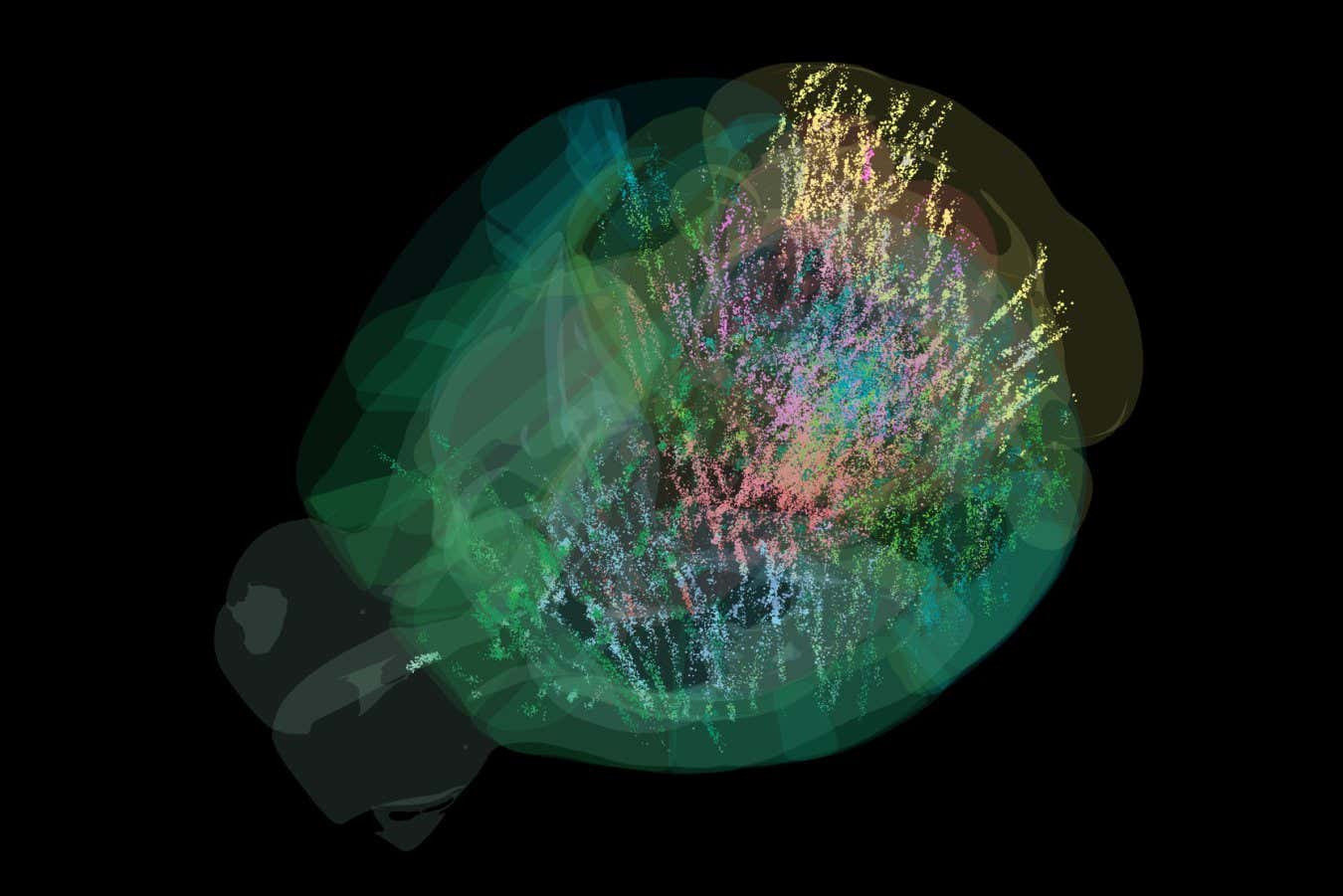
A map of a mouse’s brain showing 75,000 neurons
Dan Birman, International Brain Laboratory
The first complete activity map of a mammalian brain has revealed unprecedented insights into how decisions are made – and may even hint at the roots of that mysterious feeling we call intuition.
For decades, neuroscientists have wanted to capture activity across the whole brain at the level of individual neurons – but there is a limit to how many neurons an electrode can record from, how many electrodes can be implanted in a single brain and how many animals a single lab can test.
To overcome this, researchers across 12 labs have joined forces, each running the same experiment but recording activity from different areas of the brain, with some overlap to ensure the data they collected was consistent. The combined data from more than 650,000 neurons has now produced the first brain-wide activity map of a complex behaviour.
“This work demonstrates a completely new way of tackling complex questions in modern neuroscience,” says Benedetto De Martino at University College London, who wasn’t involved in the work. “Just as CERN [the European Organization for Nuclear Research] brought physicists together to confront the deepest problems in particle physics, this project unites labs worldwide to take on challenges too great for any single group.”
At each lab, mice were trained to move a stripy target towards the middle of a screen using a tiny Lego steering wheel. When the stripes were high contrast, the target stood out clearly. When the contrast diminished, the target all but disappeared, and the animals relied on prior knowledge to answer correctly in order to receive a reward.
Biases were built into the experiment to influence the mice’s prior expectations of where the target might be – it might appear on the left side of the screen 80 per cent of the time and on the right side 20 per cent of the time, for instance. When the bias was flipped, the mice updated their expectations accordingly.
The resulting map reveals that activity associated with decision making isn’t confined to a single region, but distributed across the brain. “There have been lots of claims about ‘this area does this’. If there’s one thing we’ve discovered from this work, it’s that no one brain area ‘decides’,” says team member Alexandre Pouget at the University of Geneva in Switzerland. “Decision making involves tens of areas that decide through a kind of consensus.”
The results also support previous work showing that decision-related signals build long before action is taken. Pouget says that even before each individual experiment began, while the mouse was still, signals associated with the next decision were apparent. These built up as the target appeared, until they reached a threshold, at which point the mouse moved the wheel.
A second paper shows how prior expectations, in this case the belief about where the target might be, are encoded in brain activity remarkably early. The researchers found that even as signals left the eye and began their journey to the thalamus, the brain’s relay centre, prior expectation of whether the target would be on the left or right had already had an effect.
This suggests that from the moment sensory data enters our brain, it is already encoded in a way that is influenced by prior knowledge, swaying our conscious decision-making process without our awareness, says Pouget. It is speculation, but this might correspond with what we perceive as intuition, he says.
What is particularly intriguing is that the encoding appears not only to be tracking recent sensory experiences, but also the recent history of choices taken, says Laurence Hunt at the University of Oxford. “This suggests that it is our own behaviour and subjective experience that shapes what we expect to see next, rather than the true, objective state of the world.”
Does this imply that our decisions are predetermined? “The brain plus the world around it forms a deterministic system. People hate that, but it’s true,” says Pouget. “It means that I can predict, to some extent, what you’re going to do before you actually decide.” However, when we acquire new data, we modulate that prior expectation, and because we don’t know how the world around us will evolve, it creates uncertainties, he says.
In the future, the researchers hope their results and collaborative approach will advance understanding of conditions such as autism. Mouse models of autism suggest these animals have difficulties updating their prior expectations when new information comes along, which fits with what we see behaviourally in people, says Pouget.
Topics:
Source link : https://www.newscientist.com/article/2494850-first-map-of-mammal-brain-activity-may-have-shown-intuition-in-action/?utm_campaign=RSS%7CNSNS&utm_source=NSNS&utm_medium=RSS&utm_content=home
Author :
Publish date : 2025-09-03 16:00:00
Copyright for syndicated content belongs to the linked Source.




